Viola edulis Spach
Common names:
Atlantic Coast Salad Violet
Synonyms:
Viola edulis Spach, Hist. Nat. Vég. (Spach) 5: 508. 1836 [replacement name at species rank for V. palmata L. var. heterophylla Elliott]; Viola palmata L. var. esculenta Elliott ex D.B.Ward, Phytologia 88: 244. 2006 [nomen superfluum]; Viola esculenta Elliott ex Greene, Pittonia 3: 314. 1898; Viola heterophylla Leconte, Ann. Lyceum Nat. Hist. New York 2: 139. 1828 ["1826"] [illegitimate homonym of Viola heterophylla (Vent.) Poir., 1808 and of Viola heterophylla Bertol., 1810]; Viola palmata L. var. heterophylla Elliott, Sketch bot. S. Carolina 1(3): 300. 1817. TYPE: [Georgia] Ogeechee river in udis etian in Pennsyl. Flor. April [no year], [S. Elliott s.n.] (holotype: CHARL!) [The protologue does not reference a type or cite a particular collection, and it does not designate a herbarium. However, Elliott does note the species is common along the Ogeechee River in Georgia and flowers in March and April. The Charleston Museum is acknowledged as holding Elliott's collection (see Taxonomic Literature II). Only one sheet in Elliott's herbarium has a plant with an attached label that matches the description and protologue, and this is accepted as the holotype.]
Description:
Acaulescent rosulate perennials from thick rhizome, ≤ 29 cm tall; foliage and peduncles light to medium green, glabrous throughout; stipules free, irregularly glandular-fimbriate; heterophyllous, leaves spreading, largest leaf blades in mid- to late chasmogamous flower into fruit shallowly to moderately pedately divided into 3 or 5 lobes, ≤ 70 × 60 mm, outline in spring narrowly ovate-triangular, in summer broadening to broadly ovate, base cordate, margins serrate to sporadically so, eciliate, apex acute; earliest chasmogamous peduncle held above the leaves; chasmogamous flower ≤ 21 mm; calyx glabrous, eciliate; lowest sepals ovate-lanceolate to ovate-triangular, acuminate; auricles prominent, entire or erose, elongating to 3 mm and erose in fruit; corolla light blue, white of throat extending onto exposed basal portion of spurred petal; spur short-globose; lateral petals densely bearded with narrowly linear to slightly clavate hairs, spurred petal glabrous; cleistogamous flowers produced during or after chasmogamous, on erect peduncle equaling or surpassing petioles; capsule 8–10 mm, green drying tan, unspotted, glabrous; seeds 1.5–1.9 × 1.0–1.2 mm, medium to dark brown or purplish-brown with dense minute raised black spots or reticulations (these occasionally sparse, seeds then appearing medium brown overall).
Similar species:
This species is most likely to be confused with the few other heterophyllous taxa with glabrous foliage, namely Viola egglestonii and Viola viarum in the Viarum species group. It differs from those two species in its less deeply divided leaf blades with 3–5 lobes, the lateral shorter and broader, glabrous spurred petal, unspotted cleistogamous capsule on rather tall erect peduncle, sharply acute sepals, elongate auricles, brown seeds with dense minute black spots or reticulations, and restriction to riparian bottomland forests on the Atlantic Coastal Plain.
Ecology:
Sandy, silty or mucky alluvial soils of low terraces and frequently inundated floodplain zones along blackwater streams and rivers, and in swamps.
Distribution:
E. Atlantic Coastal Plain, extending to just above the "fall line" in the Carolinas, se. MD (s. DelMarVa Peninsula) south to se. GA.
Rarity:
State listed in MD.
Phenology:
Chasmogamous flower February–May, chasmogamous fruit February–May, cleistogamous fruit April–August.
Affinities:
This species belongs to the Acaulescent Blue Violet lineage, sect. Nosphinium, subsect. Boreali-Americanae (W.Becker) Gil-ad, in the Edulis species group.
Hybrids:
I have collected hybrids with V. "impostor", growing intermingled with both parent species, at Elwell Ferry in Bladen Co., NC. This is apparently the first report of hybridization involving V. edulis. No information is available on hybrid reproduction, although the hybrids mostly expressed intermediate traits in foliage characteristics.
Comments:
Brainerd (1921b), Brainerd Baird (1942), Fernald (1950), Alexander (1963), Russell (1965), and Weakley et al. (2012) recognized a broadly circumscribed and geographically widely distributed coastal plain V. esculenta. Gleason and Cronquist (1991), McKinney (1992), and McKinney and Russell (2002) included it in a very broadly delimited V. palmata. Gil-ad (1995, 1997, 1998) reviewed the macromorphological features mentioned by others for distinguishing it and concluded that the taxon had no unique vegetative or reproductive traits. He reported that the seeds revealed no unique micromorphological features, and that some features resembled those of V. missouriensis, suggesting that as one parent of the putative hybrid origin of this taxon. Given the heterophylly, leaf blade division and southern distribution, he suggested the other parent species may have been V. septemloba or V. triloba [= V. palmata]. Gil-ad concluded that the present taxon most likely originated by hybridization or introgression and dismissed it. Ward (2006) examined this taxon and determined that too few characters separated it from the broadly defined V. palmata in the region, and published the unfortunate superfluous name V. palmata L. var. esculenta Elliott ex D.B.Ward. Little and McKinney (2015) reinstated a broadly defined taxon equivalent to Brainerd's and Russell's V. esculenta and followed Ward's (2006) reduction to variety under V. palmata, using the already available name var. heterophylla Elliott. We have collected and studied over a dozen populations along the eastern Atlantic Coastal Plain, from southern Maryland to eastern Georgia (twelve miles upstream on the Ogeechee River from the likely type locality of Elliott's plantation). The macromorphological traits of leaves, chasmogamous flowers, cleistogamous capsules, and seeds are highly uniform across populations, as are the dimensions and color patterns of the seeds. The micromorphologies of the seed coats are also uniform, and all plants are fully fertile. They differ collectively in several to many characteristics from other similar taxa. No populations have been confirmed, either in the field or as herbarium specimens, south or west of the Atlantic Coastal Plain of southeastern Georgia. This taxon is recognized as a distinct, narrowly circumscribed species of the Atlantic Coastal Plain. Specimens identified as "V. esculenta" off the Coastal Plain have invariably proven to be other taxa, and plants superficially resembling the present taxon in Florida and the Gulf Coast display different macromorphological features of leaves, chasmogamous flowers, cleistogamous fruits and seeds. A substantial proportion of the herbarium specimens labeled or annotated as V. esculenta are other taxa. Notwithstanding the universal application of V.esculenta Elliott ex Greene for this at species rank, the earliest correct name is V. edulis Spach. I provided a more specific "common name" for this species to distinguish it from the undescribed Viola "Gulf Coastal Plain edulis". Russell's (1965) illustration is actually V. septemloba, which frequently produces three-lobed leaf blades. This and other members of the Edulis species group are currently under study by Remington Burwell at Ohio University.
Literature Cited:
Alexander, E. J. 1963. Violaceae. In Gleason, H. A., The new Britton and Brown illustrated flora of the northeastern United States and adjacent Canada. Hafner Publishing Co., Inc., New York, NY. 552-567.
adjacent Canada. Hafner Publishing Co., New York, NY. 552-567.
Brainerd, E. 1921b. Violets of North America. Vermont Agricultural Experiment Station Bulletin 224: 1–172.
Brainerd Baird, V. 1942. Wild violets of North America. University of California Press, Berkeley, CA.
Fernald, M. L. 1950. Violaceae. In Gray’s Manual of Botany, 8th ed. American Book Company, New York, NY. 1022-1042.
Gil-ad, N. L. 1995. Systematics and evolution of Viola L. subsection Boreali-Americanae (W. Becker) Brizicky. Ph.D. dissertation. University of Michigan, Ann Arbor, MI.
Gil-ad, N. L. 1997. Systematics of Viola subsection Boreali-Americanae. Boissiera 53: 1–130.
Gil-ad, N. L. 1998. The micromorphologies of seed coats and petal trichomes of the taxa of Viola subsect. Boreali-Americanae (Violaceae) and their utility in discerning orthospecies from hybrids. Brittonia 50: 91–121.
Gleason, H. A. and A. Cronquist. 1991. Violaceae. In Manual of vascular plants of northeastern United States and adjacent Canada, 2nd ed. New York Botanical Garden, Bronx, NY. 157-163.
Little, R. J., and L. E. McKinney. 2015. Violaceae. In Flora of North America: Cucurbitaceae to Droseraceae, 106. Oxford University Press, New York, NY.
McKinney, L. E. 1992. A taxonomic revision of the acaulescent blue violets (Viola) of North America. Sida, Botanical Miscellany 7: 1–60.
McKinney, L. E., and N. H. Russell. 2002. Violaceae of the southeastern United States. Castanea 67: 369–379.
Russell, N. H. 1965. Violets (Viola) of the central and eastern United States: An introductory survey. Sida : 1–113.
Ward, D. B. 2006. Keys to the flora of Florida--14, Viola (Violaceae). Phytologia 88(3): 242-252.
Weakley, A. S., J. C. Ludwig, and J. F. Townsend. 2012. Violaceae. In Flora of Virginia. BRIT Press, Fort Worth, TX. 963-975.
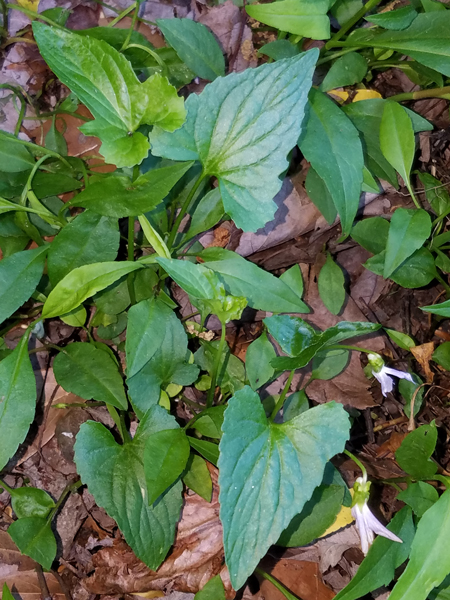
Chasmogamous flowering habit by Harvey Ballard

Chasmogamous flowering habit (early, leaf blades unlobed) by Bruce Sorrie

Chasmogamous flowering habit by Bruce Sorrie

Leaves during chasmogamous flower by Bruce Sorrie
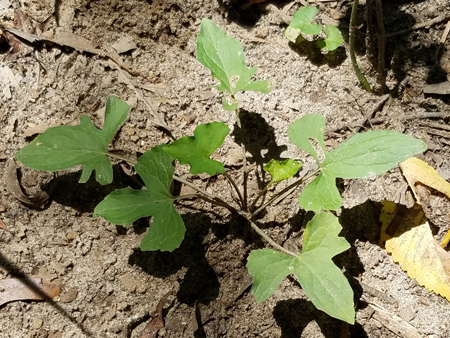
Leaves during cleistogamous fruit by Harvey Ballard

Chasmogamous flower front view by Harvey Ballard

Chasmogamous flower profile view by Harvey Ballard
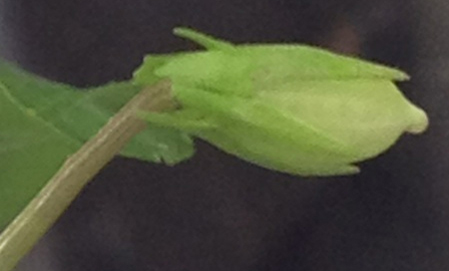
Cleistogamous fruit by Harvey Ballard

Seeds from herbarium specimen: Transplanted from NC, Columbus Co., 2.1 mi N of Pireway, H. Ballard 15-003I (BHO)
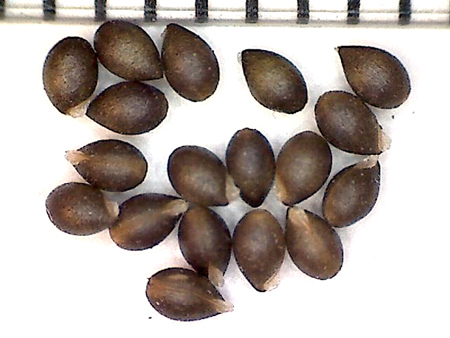
Seeds from herbarium specimen: Transplanted from GA, Bulloch Co., SW corner of intersection of Ogeechee River and Highway GA-24, H. Ballard 16-030 (BHO)
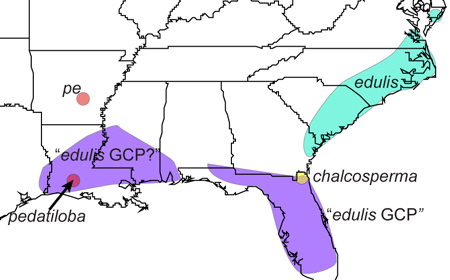
Map of the Edulis species complex by Harvey Ballard